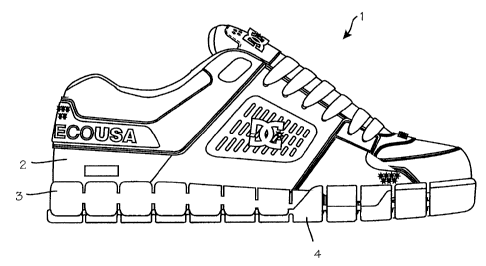Une partie des informations de ce site Web a été fournie par des sources externes. Le gouvernement du Canada n'assume aucune responsabilité concernant la précision, l'actualité ou la fiabilité des informations fournies par les sources externes. Les utilisateurs qui désirent employer cette information devraient consulter directement la source des informations. Le contenu fourni par les sources externes n'est pas assujetti aux exigences sur les langues officielles, la protection des renseignements personnels et l'accessibilité.
L'apparition de différences dans le texte et l'image des Revendications et de l'Abrégé dépend du moment auquel le document est publié. Les textes des Revendications et de l'Abrégé sont affichés :
| (12) Brevet: | (11) CA 2568319 |
|---|---|
| (54) Titre français: | CHAUSSURE DE PLANCHE A ROULETTES |
| (54) Titre anglais: | SKATEBOARD SHOE |
| Statut: | Réputé périmé |
| (51) Classification internationale des brevets (CIB): |
|
|---|---|
| (72) Inventeurs : |
|
| (73) Titulaires : |
|
| (71) Demandeurs : |
|
| (74) Agent: | BORDEN LADNER GERVAIS LLP |
| (74) Co-agent: | |
| (45) Délivré: | 2009-10-06 |
| (22) Date de dépôt: | 2006-11-16 |
| (41) Mise à la disponibilité du public: | 2007-05-18 |
| Requête d'examen: | 2008-05-22 |
| Licence disponible: | S.O. |
| (25) Langue des documents déposés: | Anglais |
| Traité de coopération en matière de brevets (PCT): | Non |
|---|
| (30) Données de priorité de la demande: | ||||||
|---|---|---|---|---|---|---|
|
Présentation et description de chaussure de planche à roulettes comprenant une pluralité de cellules de fluide pouvant se déplacer et fléchir indépendamment les unes des autres le long de la partie inférieure de la semelle intercalaire. La semelle intercalaire sert à la fois de semelle de stabilisation et de semelle d'amortissement d'impact, tout en améliorant l'ajustement de la chaussure de manière à ce qu'elle se déplace avec le pied.
A skateboard shoe comprising a plurality of fluid chambers able to move and flex independently from one another along the bottom portion of the midsole is shown and described. The midsole acts as both a stabilizing midsole and an impact cushioning midsole while improving the fit of the shoe so it moves with the foot.
Note : Les revendications sont présentées dans la langue officielle dans laquelle elles ont été soumises.
Note : Les descriptions sont présentées dans la langue officielle dans laquelle elles ont été soumises.

Pour une meilleure compréhension de l'état de la demande ou brevet qui figure sur cette page, la rubrique Mise en garde , et les descriptions de Brevet , États administratifs , Taxes périodiques et Historique des paiements devraient être consultées.
| Titre | Date |
|---|---|
| Date de délivrance prévu | 2009-10-06 |
| (22) Dépôt | 2006-11-16 |
| (41) Mise à la disponibilité du public | 2007-05-18 |
| Requête d'examen | 2008-05-22 |
| (45) Délivré | 2009-10-06 |
| Réputé périmé | 2019-11-18 |
Il n'y a pas d'historique d'abandonnement
Les titulaires actuels et antérieures au dossier sont affichés en ordre alphabétique.
| Titulaires actuels au dossier |
|---|
| DC SHOES, INC. |
| Titulaires antérieures au dossier |
|---|
| ABADJIAN, JOSEPH HAROUTIOUN |
| CHANG, WEI-EN |